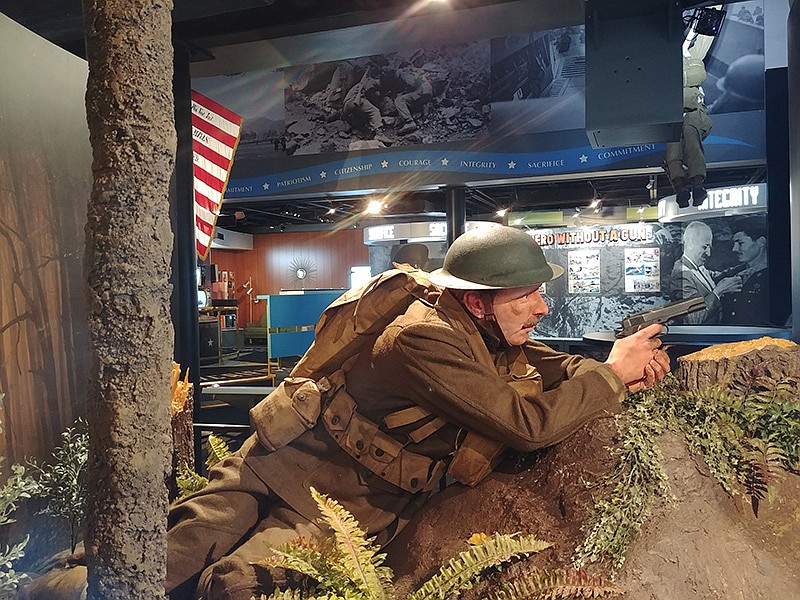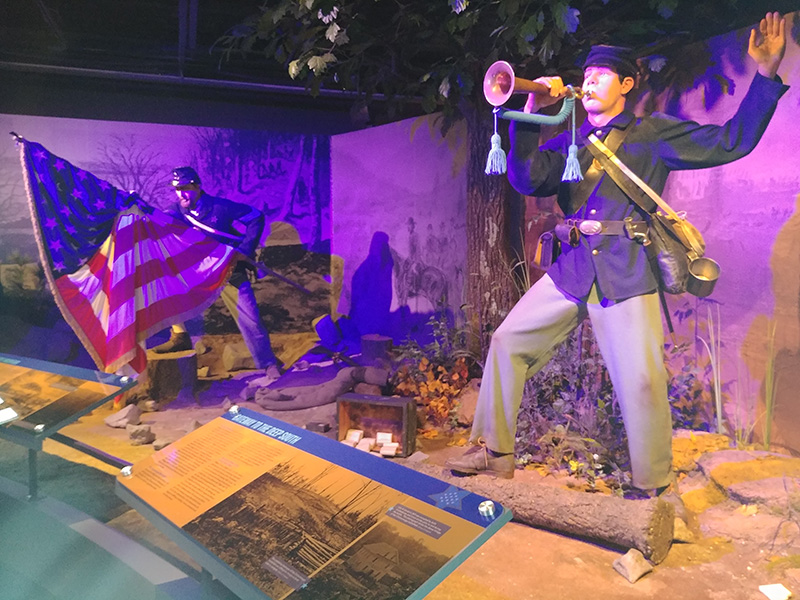On a rainy day in April 1862, a secret group of Union soldiers commandeered a locomotive and literally tore up the tracks on their way to Chattanooga, a Confederate stronghold where they were ultimately captured. Nearly 159 years later, on a drizzly afternoon in March, I went to the Charles H. Coolidge National Medal of Honor Heritage Center which honors the heroic acts of those first Medal of Honor recipients and the many who have followed in their footsteps.
A journalist and nearly lifelong Chattanooga transplant, I was familiar with some of the stories expounded on in the museum - like that of Dr. Mary Walker, the only woman to receive the medal, and fellow recipient Desmond Doss, "the conscientious objector" memorialized in Mel Gibson's 2016 film "Hacksaw Ridge," both of whom claimed Chattanooga as their home for a time. I am aware and proud of the fact that Chickamauga Battlefield, one of my favorite places to walk, is the nation's first military park and a model for the rest of the country; the first site where those who'd charged at each other across that same terrain united to honor those who had fallen there, coordinating on the placement of markers to the best of their collective memory.
So the museum was a bit of a shift for me mentally. It did not necessarily enlighten my mind. But it ignited my spirit.
(READ MORE: Chattanoogan Charles Coolidge, the nation's oldest Medal of Honor recipient, dies at 99)
The attraction does not like to be called a museum, and I now understand why. It is not a place of dusty history, though it does contain artifacts: pristine uniforms; dozens of personal Medals of Honor; the first and only gun Doss held, taken and hidden during a fight between his father and uncle when he was a boy.
Instead, the center seeks to be a beacon, a reminder of the ideals prevalent in the historical anecdotes and encounters featured in other museums - and which remain relevant today.
Rather than focusing on the straight facts and historical context of various conflicts, the center hones in on the specific acts of those brave enough to earn the nation's highest military honor, starting with the Civil War story of Andrews' Raiders and stretching through the War on Terror.
As you make your way through the self-guided exhibits, computer kiosks feature interviews with Medal of Honor recipients who offer personal insight into the values for which the medal and museum stand: patriotism, citizenship, courage, integrity, sacrifice and commitment. I found myself soaking up their sage words, even as I glided past many of the written tableaux.
That focus on character is at the heart of what the center seeks to preserve, both through its guest experience and through its educational outreach with local students, a primary part of its purpose.
Having celebrated its grand opening on Feb. 22, 2020, just before the pandemic forced attractions, schools and businesses to close, the center already has footage of its character-building lessons from local schools. This spring, it launched the Nathaniel C. Hughes Jr. History Club for middle and high schoolers. Free lesson plans and educational activities are available on the museum's website, and free copies of local historian Linda Moss Mines' new children's book, "The Making of a Hero," will be given out to families who visit the museum between March 25 - Medal of Honor Day - and April 11.
(READ MORE: The story of Medal of Honor recipient Charles Coolidge)
If you go
Where: 2 W. Aquarium Way, Suite 104When: Monday-Saturday, 9 a.m. to 5 p.m.; Sunday, 10 a.m. to 3:30 p.m.; last ticket sold 45 minutes prior to closingCost: Adults, ages 13-64, $13.95; seniors and military, $11.95; children ages 5-12, $9.95Good to know: You can walk up and buy tickets, but only 10 new guests are allowed in the galleries every 15 minutes.
I never visited the volunteer-run iteration previously housed at Northgate Mall from which the state-of-the art center sprang. But I will posit that while the docents' sweet, grandmotherly personalities and engaged interest suggested to me that they are some of the same volunteers, the downtown attraction is a far cry from that corner collection. Touch-screens invite guests to look up relatives or medal recipients from various conflicts. The exhibits offer immersive surroundings, helping place you in the action.
They say the museum takes about 45 minutes to tour. I am a slow reader. We were there nearly two hours. I was honestly a little overwhelmed by the amount of reading to be done, and initially a little underwhelmed by what I chose to focus on: the more prominent exhibit-explaining plaques that set the scene for the featured medal recipients' actions. If I had it to do over again, I would concentrate my time and energy on the blue kiosks off to the side of each exhibit, which delve more into the details of each recipient's moments of sacrifice.
As I stood reading about Kyle Carpenter near the end of my visit, tears welled up in my eyes. While serving in Afghanistan at the age of 20, he positioned himself between a grenade and his comrade, losing an eye, most of his teeth and shattering his lower jaw and right arm, but saving the other man's life. And Carpenter's bravery did not end there. Calling it his "Alive Day," he fought through the years of surgeries and physical therapy that ensued, determined to compete in the Marine Corps Marathon, which he ultimately completed three times. He put himself through college, earning a degree in international studies, and recently authored a book aimed at helping everyone turn their wounds into motivation to live their best life.
I found myself reflecting on Carpenter's story the day after my visit. And that's when I truly understood the center's purpose.
"The Medal of Honor recipients are ordinary people who, one time in their lives, faced circumstances when they decided that destiny, as they understood it to be, was unacceptable. They found within themselves the potential to literally change fate. This same potential resides in every American and it is worthy of respect and celebration without the need of a medal or uniform." - Paul Bucha, awarded the Medal of Honor for actions in the Vietnam War

